7 apr 2016
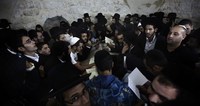
Violent clashes broke out at dawn Thursday after nearly 1,000 Israeli settlers stormed Youssef Tomb east of Nablus, while similar clashes erupted in the vicinity of Al-Najah University.
Local sources said that a number of Israeli buses carrying nearly 1,000 Israeli settlers stormed Balata town at 1 a.m. under heavy military protection, which led to the outbreak of violent confrontations with local youths.
At least four young men were injured with live and rubber bullets while dozens others suffered effects of teargas inhalation.
On the other hand, similar clashes erupted in the vicinity of al-Najah University when Israeli soldiers violently stormed student hostels.
On Wednesday, three minors were arrested while six other youths were injured with rubber bullets as clashes erupted in al-Khuder town west of Bethlehem. One of the injured young men was seriously injured in his head.
The clashes erupted when Israeli forces stormed the town since the early morning hours amid heavy fire of teargas bombs and rubber bullets. Dozens of homes were violently raided and searched, causing a state of tension among locals.
Local sources said that a number of Israeli buses carrying nearly 1,000 Israeli settlers stormed Balata town at 1 a.m. under heavy military protection, which led to the outbreak of violent confrontations with local youths.
At least four young men were injured with live and rubber bullets while dozens others suffered effects of teargas inhalation.
On the other hand, similar clashes erupted in the vicinity of al-Najah University when Israeli soldiers violently stormed student hostels.
On Wednesday, three minors were arrested while six other youths were injured with rubber bullets as clashes erupted in al-Khuder town west of Bethlehem. One of the injured young men was seriously injured in his head.
The clashes erupted when Israeli forces stormed the town since the early morning hours amid heavy fire of teargas bombs and rubber bullets. Dozens of homes were violently raided and searched, causing a state of tension among locals.
6 apr 2016

The Israeli Occupation Forces (IOF) opened fire Tuesday evening at Palestinian farmers and shepherds east of Khan Younis south of Gaza Strip.
Local sources affirmed that Israeli forces stationed at the border areas opened heavy fire at Palestinian farmers while tending to their agricultural lands east of Khan Younis.
No injuries were reported during the shooting attack.
The farmers were forced to leave their lands due to heavy firing. Meanwhile, Israeli forces built a sand berm along the southern Gaza borders before deploying in large numbers in the area.
Eyewitnesses told Quds Press that Israeli forces carried out a limited incursion east of Rafah accompanied with a number of bulldozers and military vehicles.
The bulldozers built a huge sand berm where nearly 50 Israeli soldiers were barricaded.
The Israeli shooting attack and incursion into Gaza borders came as part of Israeli almost daily violations of the ceasefire agreement reached between Palestinian resistance and Israeli army under Egyptian mediation on Aug. 26, 2014.
Local sources affirmed that Israeli forces stationed at the border areas opened heavy fire at Palestinian farmers while tending to their agricultural lands east of Khan Younis.
No injuries were reported during the shooting attack.
The farmers were forced to leave their lands due to heavy firing. Meanwhile, Israeli forces built a sand berm along the southern Gaza borders before deploying in large numbers in the area.
Eyewitnesses told Quds Press that Israeli forces carried out a limited incursion east of Rafah accompanied with a number of bulldozers and military vehicles.
The bulldozers built a huge sand berm where nearly 50 Israeli soldiers were barricaded.
The Israeli shooting attack and incursion into Gaza borders came as part of Israeli almost daily violations of the ceasefire agreement reached between Palestinian resistance and Israeli army under Egyptian mediation on Aug. 26, 2014.

More than 17 Palestinian were hit and injured with rubber bullets while dozens others choked on teargas Tuesday evening as clashes broke out in Issawiya town in occupied Jerusalem.
Medical sources said that 17 slight rubber bullet injuries were reported during the clashes that broke out in Issawiya town when Israeli policemen stormed the town via its eastern and northern entrances amid heavy fire of teargas bombs.
The local youths responded by throwing stones and Molotov cocktails at the policemen. On other hand, violent clashes broke out in Surif town north of al-Khalil after Israeli occupation forces(IOF) stormed the prisoner Musab Agneymat’s house and handed over a demolition notification to his family.
IOF soldiers in 11 military vehicles stormed the town which led to the outbreak of violent confrontations amid heavy firing of teargas bombs and rubber and live bullets, eyewitnesses told the PIC reporter.
The 17-year-old Agneymat was shot and seriously injured by Israeli gunfire before his arrest for allegedly trying to carry out a stabbing attack on October 3, 2015.
Similar clashes were reported in Duma town south of Nablus after a group of settlers organized a march in support of the Jewish terror group suspected of launching an arson attack in July, in which sleeping 18-month-old Palestinian Ali Dawabsheh was burned to death. A week after the attack, Ali's father, Saad Dawabsheh, died from his wounds. The toddler's mother Reham Dawabsheh, 26, died in September, succumbing to third-degree burns over at least 80 percent of her body.
Four-year-old Ahmed Dawabsheh, the elder son, is still receiving treatment after sustaining burns to 60 percent of his body. Several rubber bullet injuries and teargas suffocation cases were reported during the clashes.
Medical sources said that 17 slight rubber bullet injuries were reported during the clashes that broke out in Issawiya town when Israeli policemen stormed the town via its eastern and northern entrances amid heavy fire of teargas bombs.
The local youths responded by throwing stones and Molotov cocktails at the policemen. On other hand, violent clashes broke out in Surif town north of al-Khalil after Israeli occupation forces(IOF) stormed the prisoner Musab Agneymat’s house and handed over a demolition notification to his family.
IOF soldiers in 11 military vehicles stormed the town which led to the outbreak of violent confrontations amid heavy firing of teargas bombs and rubber and live bullets, eyewitnesses told the PIC reporter.
The 17-year-old Agneymat was shot and seriously injured by Israeli gunfire before his arrest for allegedly trying to carry out a stabbing attack on October 3, 2015.
Similar clashes were reported in Duma town south of Nablus after a group of settlers organized a march in support of the Jewish terror group suspected of launching an arson attack in July, in which sleeping 18-month-old Palestinian Ali Dawabsheh was burned to death. A week after the attack, Ali's father, Saad Dawabsheh, died from his wounds. The toddler's mother Reham Dawabsheh, 26, died in September, succumbing to third-degree burns over at least 80 percent of her body.
Four-year-old Ahmed Dawabsheh, the elder son, is still receiving treatment after sustaining burns to 60 percent of his body. Several rubber bullet injuries and teargas suffocation cases were reported during the clashes.
5 apr 2016
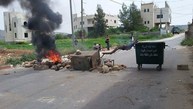
A Palestinian young man was wounded in Beit Furik village, east of Nablus city, on Tuesday during confrontations between Israeli occupation forces (IOF) and young men in the village.
Local sources told the PIC reporter that Munther Khatatbe was injured in his hand with a rubber-coated bullet in the clashes that took place at Beit Dajan junction.
They said that the confrontations erupted after the IOF soldiers were leaving Beit Dajan where they had delivered demolition notifications and confiscated a tractor.
Local sources told the PIC reporter that Munther Khatatbe was injured in his hand with a rubber-coated bullet in the clashes that took place at Beit Dajan junction.
They said that the confrontations erupted after the IOF soldiers were leaving Beit Dajan where they had delivered demolition notifications and confiscated a tractor.
|
|
Israeli forces stormed the campus of al-Quds University in the occupied West Bank village of Abu Dis east of Jerusalem's Old City early on Tuesday morning, damaging property, local sources told Ma’an.
Israeli troops raided the university campus at 3 a.m. and left at 5 a.m. For two hours, the soldiers locked campus security guards in one room after breaking their walkie-talkies. The soldiers then ransacked a building hosting the Dean of Students and destroyed property, including printers. The sources added that Israeli forces damaged a Christmas tree that was standing in front of the Dean of Students office. Israeli forces also stormed the Faculty of Islamic Studies, and broke into |
the students activity center, destroying material in an exhibition students were working on.
An Israeli army spokesperson told Ma’an that as part of “operational activity,” Israeli forces seized material belonging to Hamas’ educational arm al-Kutla al-Islamiyah, including propaganda for Hamas.
The spokesperson added that such propaganda was used for “incitement,” and encouraged “terrorism against Israeli citizens and security forces.”
Both Palestinian and Israeli leadership have accused each other of inciting and encouraging the current wave of upheaval in the occupied Palestinian territory and Israel that began in October.
Israeli forces have stormed university campuses across the occupied Palestinian territory several times since the beginning of 2016, with al-Quds University in particular finding itself a focal point of violent clashes between Palestinian students and Israeli soldiers.
Hundreds of Israeli soldiers stormed al-Quds University in January, confiscating equipment and documents belonging to its student union. Earlier that month, Israeli forces also confiscated and damaged equipment at Birzeit University in a predawn raid.
In March, Israeli forces raided the Tulkarem-area al-Khadoori University twice in 18 hours. The Arab American University in the occupied West Bank city of Jenin was also raided by Israeli forces in March.
An Israeli army spokesperson told Ma’an that as part of “operational activity,” Israeli forces seized material belonging to Hamas’ educational arm al-Kutla al-Islamiyah, including propaganda for Hamas.
The spokesperson added that such propaganda was used for “incitement,” and encouraged “terrorism against Israeli citizens and security forces.”
Both Palestinian and Israeli leadership have accused each other of inciting and encouraging the current wave of upheaval in the occupied Palestinian territory and Israel that began in October.
Israeli forces have stormed university campuses across the occupied Palestinian territory several times since the beginning of 2016, with al-Quds University in particular finding itself a focal point of violent clashes between Palestinian students and Israeli soldiers.
Hundreds of Israeli soldiers stormed al-Quds University in January, confiscating equipment and documents belonging to its student union. Earlier that month, Israeli forces also confiscated and damaged equipment at Birzeit University in a predawn raid.
In March, Israeli forces raided the Tulkarem-area al-Khadoori University twice in 18 hours. The Arab American University in the occupied West Bank city of Jenin was also raided by Israeli forces in March.
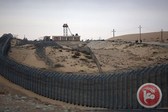
Israeli forces opened fire on Palestinian farmers and leveled lands in the Gaza Strip Tuesday morning, locals said.
Witnesses told Ma’an they saw three Israeli bulldozers enter the Palestinian side of the Gaza borderline and level lands near the border fence on the outskirts of al-Nahdha neighborhood east of Rafah. No injuries were reported.
Separately, Israeli forces reportedly opened fire on Palestinian farmers tending their land in al-Najjar neighborhood near the village of Khuzaa in the southern Gaza Strip. No injuries have been reported.
An Israeli army spokesperson told Ma'an they were looking into the reports.
Israeli military forces routinely enter the Gaza Strip near the “buffer zone,” which lies on the border between the besieged enclave and Israel.
Israeli military activities, which have become almost daily occurrences, often interfere with Palestinian farmers whose land lies in the area. Approximately 35 percent of Palestinian agricultural land in Gaza is inaccessible without high personal risk, according to the Palestinian Center for Human Rights.
The UN Office for the Coordination of Humanitarian Affairs reported in February at least 42 cases of Israeli forces opening fire on Palestinians in the buffer zone, on both land and sea sides.
Witnesses told Ma’an they saw three Israeli bulldozers enter the Palestinian side of the Gaza borderline and level lands near the border fence on the outskirts of al-Nahdha neighborhood east of Rafah. No injuries were reported.
Separately, Israeli forces reportedly opened fire on Palestinian farmers tending their land in al-Najjar neighborhood near the village of Khuzaa in the southern Gaza Strip. No injuries have been reported.
An Israeli army spokesperson told Ma'an they were looking into the reports.
Israeli military forces routinely enter the Gaza Strip near the “buffer zone,” which lies on the border between the besieged enclave and Israel.
Israeli military activities, which have become almost daily occurrences, often interfere with Palestinian farmers whose land lies in the area. Approximately 35 percent of Palestinian agricultural land in Gaza is inaccessible without high personal risk, according to the Palestinian Center for Human Rights.
The UN Office for the Coordination of Humanitarian Affairs reported in February at least 42 cases of Israeli forces opening fire on Palestinians in the buffer zone, on both land and sea sides.
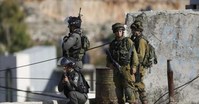
The Israeli Occupation Forces (IOF) launched at dawn Monday a large scale raid and arrest campaign across West Bank and occupied Jerusalem.
Two leaders in Hamas Movement were among the detainees. According to the PIC news reporter, the Israeli forces arrested the two leaders in Hamas Movement Sheikh Nazih Abu Oun, from Jenin, and Adnan al-Hussari, from Tulkarem.
Local sources told the PIC reporter that large numbers of Israeli soldiers stormed Joba’a town in Jenin and broke into Sheikh Abu Oun’s house before violently searching it.
Sheikh Au Oun was arrested more than once by Israeli forces and spent 15 years behind Israeli bars.
IOF soldiers also stormed and violently searched a second home in Aker refugee camp in Jenin belonging to Ahmed Salatneh, head of the Jenin Zakat Committee.
Following the raid, clashes broke out in the city. Dozens of civilians choked on teargas. Meanwhile, three youths were arrested in Ramallah and Salfit, while six others were detained in al-Khalil south of occupied West Bank.
A similar arrest campaign was also carried out in occupied Jerusalem, where 11 youths were detained including five youths from Hezma town. In Jenin, a number of local youths suffered effects of teargas inhalation as clashes broke out overnight in Beit Qad east of the city.
Local sources affirmed to the PIC reporter that IOF soldiers in nearly five military vehicles stormed the town which led to the outbreak of the clashes. Several youths were also detained and investigated during the clashes. A number of make-shift checkpoints were erected in the nearby towns in Jenin.
Two leaders in Hamas Movement were among the detainees. According to the PIC news reporter, the Israeli forces arrested the two leaders in Hamas Movement Sheikh Nazih Abu Oun, from Jenin, and Adnan al-Hussari, from Tulkarem.
Local sources told the PIC reporter that large numbers of Israeli soldiers stormed Joba’a town in Jenin and broke into Sheikh Abu Oun’s house before violently searching it.
Sheikh Au Oun was arrested more than once by Israeli forces and spent 15 years behind Israeli bars.
IOF soldiers also stormed and violently searched a second home in Aker refugee camp in Jenin belonging to Ahmed Salatneh, head of the Jenin Zakat Committee.
Following the raid, clashes broke out in the city. Dozens of civilians choked on teargas. Meanwhile, three youths were arrested in Ramallah and Salfit, while six others were detained in al-Khalil south of occupied West Bank.
A similar arrest campaign was also carried out in occupied Jerusalem, where 11 youths were detained including five youths from Hezma town. In Jenin, a number of local youths suffered effects of teargas inhalation as clashes broke out overnight in Beit Qad east of the city.
Local sources affirmed to the PIC reporter that IOF soldiers in nearly five military vehicles stormed the town which led to the outbreak of the clashes. Several youths were also detained and investigated during the clashes. A number of make-shift checkpoints were erected in the nearby towns in Jenin.
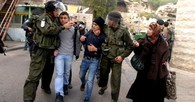
The Israeli Ofer military court on Monday sentenced a Palestinian girl to 45 days in jail at the same time as Israeli soldiers detained two Palestinian children.
Palestinian citizen Nasr Atatra said the Salem military court ruled for sentencing his 16-year-old daughter Shaymaa to one month and a half in jail and a fine of 1,100 U.S. dollars.
The girl, held in the HaSharon jail, was kidnapped by the occupation army on March 15 at the Zaatara checkpoint, in southern Nablus, on allegations that she attempted to carry out an anti-occupation stabbing against an Israeli soldier.
Meanwhile, the Israeli occupation army arrested the two Palestinian children Bahaa and Mus’ab al-Shawaheen, in al-Khalil’s southern town of Yatta, after they had been chased down and aggressively attacked by Israeli extremist settlers.
Activist Rateb al-Jabour said the occupation troops who showed up at the scene opened fire at the two minor captives to scare them into stopping and handcuffed them before they detained them for long hours.
In a related development, the Israeli occupation authorities released two Palestinian children, from Occupied Jerusalem, after they had been locked up for six months in Israeli jails.
One of the newly-released children was identified as 16-year-old Amr Amer Abu Madi, arrested on October 13 on charges of stone-throwing. The other minor was identified as 17-year-old Samer Hamza Shludi.
Palestinian citizen Nasr Atatra said the Salem military court ruled for sentencing his 16-year-old daughter Shaymaa to one month and a half in jail and a fine of 1,100 U.S. dollars.
The girl, held in the HaSharon jail, was kidnapped by the occupation army on March 15 at the Zaatara checkpoint, in southern Nablus, on allegations that she attempted to carry out an anti-occupation stabbing against an Israeli soldier.
Meanwhile, the Israeli occupation army arrested the two Palestinian children Bahaa and Mus’ab al-Shawaheen, in al-Khalil’s southern town of Yatta, after they had been chased down and aggressively attacked by Israeli extremist settlers.
Activist Rateb al-Jabour said the occupation troops who showed up at the scene opened fire at the two minor captives to scare them into stopping and handcuffed them before they detained them for long hours.
In a related development, the Israeli occupation authorities released two Palestinian children, from Occupied Jerusalem, after they had been locked up for six months in Israeli jails.
One of the newly-released children was identified as 16-year-old Amr Amer Abu Madi, arrested on October 13 on charges of stone-throwing. The other minor was identified as 17-year-old Samer Hamza Shludi.
4 apr 2016

A 12-year-old child was hit and seriously injured with a rubber bullet in his head as clashes erupted in Issawiya town northeast of occupied Jerusalem on Monday evening.
The child was immediately transferred to al-Makassed Hospital to be then moved to Hadassah Ein Kerem Hospital due to his serious health condition.
The clashes broke out when Israeli police forces brutally stormed the town amid heavy fire of teargas bombs and sound grenades. Dozens of youths also suffered effects of teargas inhalation during the clashes.
Meanwhile, Israeli policemen arrested Monday afternoon Imam (preacher) of al-Sahaba Mosque Samir al-Elmi after violently breaking into and searching his house in Sawwanah neighborhood.
A lap top, mobile phones, a tablet, and important files in addition to an amount of cash money estimated at US$2,390 were confiscated during the raid, family sources affirmed to Quds Press.
Another young man was arrested for allegedly throwing stones at Israeli military vehicles which stormed Issawiya town. Seven Palestinians were injured with rubber bullets during similar clashes that broke out in Issawiya town on Sunday. Dozens others choked on tear gas.
The child was immediately transferred to al-Makassed Hospital to be then moved to Hadassah Ein Kerem Hospital due to his serious health condition.
The clashes broke out when Israeli police forces brutally stormed the town amid heavy fire of teargas bombs and sound grenades. Dozens of youths also suffered effects of teargas inhalation during the clashes.
Meanwhile, Israeli policemen arrested Monday afternoon Imam (preacher) of al-Sahaba Mosque Samir al-Elmi after violently breaking into and searching his house in Sawwanah neighborhood.
A lap top, mobile phones, a tablet, and important files in addition to an amount of cash money estimated at US$2,390 were confiscated during the raid, family sources affirmed to Quds Press.
Another young man was arrested for allegedly throwing stones at Israeli military vehicles which stormed Issawiya town. Seven Palestinians were injured with rubber bullets during similar clashes that broke out in Issawiya town on Sunday. Dozens others choked on tear gas.
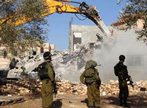
Israeli soldiers invaded, on Monday morning, Khirbit al-Marajem village, south of the northern West Bank city of Nablus, and demolished three Palestinian homes. Many Palestinians suffered the effects of tear gas inhalation.
Ghassan Daghlas, a Palestinian official in charge of Israeli Settlements file, in the northern part of the occupied West Bank, said many Israeli armored vehicles and bulldozers invaded the village, after surrounding it, and demolished three homes.
Daghlas added that one of the demolished homes belongs to Jamal Tawil, and the two other homes belong to Hisham Jadrawi.
The Israeli army claimed the three demolished properties were built without obtaining permits from the "Civil Administration Office," run by the military in the occupied West Bank.
Medical sources said many Palestinians suffered the effects of tear gas inhalation, after the soldiers fired many gas bombs during clashes that took place following the invasion and destruction of property.
Ghassan Daghlas, a Palestinian official in charge of Israeli Settlements file, in the northern part of the occupied West Bank, said many Israeli armored vehicles and bulldozers invaded the village, after surrounding it, and demolished three homes.
Daghlas added that one of the demolished homes belongs to Jamal Tawil, and the two other homes belong to Hisham Jadrawi.
The Israeli army claimed the three demolished properties were built without obtaining permits from the "Civil Administration Office," run by the military in the occupied West Bank.
Medical sources said many Palestinians suffered the effects of tear gas inhalation, after the soldiers fired many gas bombs during clashes that took place following the invasion and destruction of property.
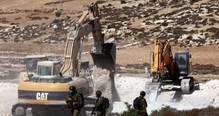
The Israeli Occupation Forces (IOF) demolished on Monday three homes of three Palestinians suspected of carrying out anti-occupation attacks in Qabatia town in Jenin.
Local sources affirmed that Israeli forces stormed the town in large numbers and surrounded the homes of the three martyrs Ahmad Abu al-Rub, 21, Mohammed Kamil, 20, and Ahmed Zakarneh, 22, before starting the demolition process.
Violent clashes broke out throughout the town during the demolition process, the sources added.
Two young men suffered gunshot injuries during the clashes while five others were hit and injured with rubber bullets.
Eyewitnesses affirmed that nearly 300 Israeli soldiers stormed the town and participated in the demolition process after forcing the three families to evacuate their houses in few minutes.
Another Israeli force in civilian clothing arrested a young man during the confrontations, according to locals. On February 3, three Palestinian youths from Qabatia town were shot and killed for allegedly carrying out anti-occupation attack in occupied Jerusalem.
Since Oct. 2015, Israel has stepped up punitive home demolitions as a means of punishing the families of Palestinians who allegedly carried out attacks against Israelis or were suspected of such actions.
This policy left hundreds of people – including young children – homeless, although they themselves were accused of no wrongdoing. Commenting on the Israeli demolition process, the spokesman for Hamas Movement Hussam Badran said that the “Israeli demolition policy will not deter our resistance from carrying out anti-occupation attacks.”
Badran warned that such punitive measures will add fuel to the fire, calling on Palestinian people to support the families whose homes were demolished.
Local sources affirmed that Israeli forces stormed the town in large numbers and surrounded the homes of the three martyrs Ahmad Abu al-Rub, 21, Mohammed Kamil, 20, and Ahmed Zakarneh, 22, before starting the demolition process.
Violent clashes broke out throughout the town during the demolition process, the sources added.
Two young men suffered gunshot injuries during the clashes while five others were hit and injured with rubber bullets.
Eyewitnesses affirmed that nearly 300 Israeli soldiers stormed the town and participated in the demolition process after forcing the three families to evacuate their houses in few minutes.
Another Israeli force in civilian clothing arrested a young man during the confrontations, according to locals. On February 3, three Palestinian youths from Qabatia town were shot and killed for allegedly carrying out anti-occupation attack in occupied Jerusalem.
Since Oct. 2015, Israel has stepped up punitive home demolitions as a means of punishing the families of Palestinians who allegedly carried out attacks against Israelis or were suspected of such actions.
This policy left hundreds of people – including young children – homeless, although they themselves were accused of no wrongdoing. Commenting on the Israeli demolition process, the spokesman for Hamas Movement Hussam Badran said that the “Israeli demolition policy will not deter our resistance from carrying out anti-occupation attacks.”
Badran warned that such punitive measures will add fuel to the fire, calling on Palestinian people to support the families whose homes were demolished.
